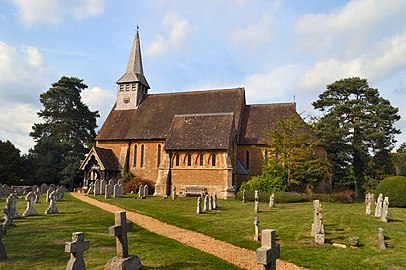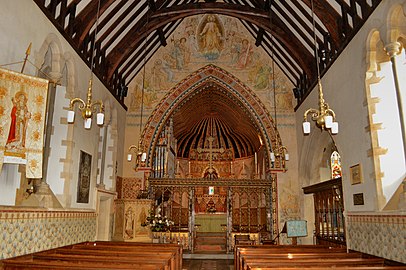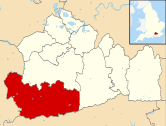
Hascombe

| Hascombe | |
|---|---|
 Hascombe village, looking towards St Peter's Church and The White Horse public house | |
Location within Surrey | |
| Population | 307 (2011 Census)[1] |
| OS grid reference | SU997397 |
| District | |
| Shire county | |
| Region | |
| Country | England |
| Sovereign state | United Kingdom |
| Post town | Godalming |
| Postcode district | GU8 |
| Dialling code | 01483 |
| Police | Surrey |
| Fire | Surrey |
| Ambulance | South East Coast |
| UK Parliament | |
Hascombe is a village and civil parish in Surrey, England. It is around 3 miles (4.8 km) southeast of Godalming in the Borough of Waverley. The settlement contains a large cluster of cottages and country estates, St Peter's Church, the village green, a fountain, pond, a central public house and is surrounded by steep wooded hillsides.

History
The earliest records of the settlement are from 1241, in which it appears as Hasecumbe and under the modern spelling "Hascombe". Additional variants from the 13th century include Hescumbe (1243), Hascumbe (1255), Hassecumbe (1266) and Escumbe. (c. 1270). The second part of the name "‑combe", is generally agreed to derive from the Old English (OE) cumb, meaning a valley.[2] The first element "Has‑" may come from hese or hæse (OE) meaning "brushwood", or from hægtesse (OE) meaning "witch".[2][3]

Above the village is Hascombe Hill, the site of an Iron Age multivallate hillfort. Pottery sherds recovered from the 2.5 ha (6.2-acre) site suggest that it was occupied between 200 and 50 BCE.[4][5]

Hascombe is thought to have been part of the Manor of Bramley until the early 14th century.[6]

Landmarks
The public house, The White Horse, a 16th- or 17th-century building with many later extensions, is constructed from the local Bargate stone, a local term for the hard masonry material which is a type of limestone with traces of greensand.[7]

In the southern part of the main street a metre-high, 4 metre square animal pound appears to the west: according to English Heritage, this is a stone 15th century construction and is listed for its uniqueness in the county.[8]

St Peter's Church
St Peter's Church, which is grade II* listed, was rebuilt during the mid-19th century, and the new church consecrated in June 1864. [9] The original church dated from the 13th century but by 1862, when Canon Vernon Musgrave became rector, it was described as being in a poor condition. The architect of the new church was Henry Woodyer, a pupil of William Butterfield. The church is built of local Bargate stone, with a simple nave, chancel, and lady chapel. The roof rafters are cusped and gilded. The stained-glass is mostly by Hardman Powell and the decoration is by J A Pippet, a freelance artist employed by Hardman.

The medieval rood screen, made from Jerusalem olive trees and featuring elaborate carvings and paintings, remains from the old church and was restored in 1864 and decorated by Hardman and Powell. The font of Purbeck marble dates back to 1690.

Poet Laureate Sir John Betjeman described the church as "a Tractarian work of art".[10] The walls of the nave are decorated with the scene of the ‘miraculous draught of fishes’ with 'one hundred and fifty and three' fishes caught in a net dragged by the six disciples. Above the chancel arch is a painting of the Last Judgement, and on the inside of the arch is a picture of our Lord with angels. The walls of the choir and sanctuary have scenes from the Bible depicting the ministry of Angels. The stained glass in the chancel are scenes from the life of our Lord. The central window shows Christ on the cross. The reredos above the altar shows the Adoration of the Lamb. At the entrance to the chancel is a Victorian brass to Canon Vernon Musgrave. The pulpit panels show our Lord together with Noah, St Peter, and St John the Baptist. The west window by William Holland shows Jesus in the fishing boat calming the storm, in memory of Conyers Middleton who was rector from 1747 to his death in 1750.[11] The Lady Chapel was created in 1935 and contains a squint window. The east window in the Lady Chapel is by Clayton and Bell and the lancet windows by Hardman Powell commemorating the Godman family.

The damming of a stream in the 15th century created the Church Pond.

-
St Peter's Church
-
View of the nave
-
Miraculous draught of fishes
-
The sanctuary
-
The rood screen
-
West window
Geography
Hascombe's natural fresh-water spring attracts many visitors: the fountain itself was commissioned in 1887 by local landowner Edward Lee Rowcliffe as a memorial to his late brother.

Hills
A promontory that adjoins Hascombe Hill from 1796 to 1816 Hascombe hosted a station in the shutter telegraph chain which connected the Admiralty in London to its naval ships in Portsmouth.

Hascombe has the following summits in the large Surrey Hills AONB:

| Hill | Elevation | Rank within Surrey | Range |
|---|---|---|---|
| Hascombe Hill | 197m | 14th | Greensand Ridge |
| Breakneck Hill | 189m | 15th | Greensand Ridge |
| Hydon's Ball | 181m | 16th | Greensand Ridge[12] |
Residents
Hascombe is in a ward, Bramley, Busbridge and Hascombe, which has much higher than average home ownership than the South East Region and nation.[13] Current and former residents include the film star Dirk Bogarde;[14] Russian businessman Boris Berezovsky;[15] former member of The Jam, Bruce Foxton;[16] boss of McLaren F1 Formula One racing team, Ron Dennis; broadcaster Chris Evans; and actor Billie Piper.

The wildlife artist Archibald Thorburn lived and died in the village. His grave lies in the parish churchyard. It was during a stay at Hoe Farm in 1915 that statesman and future Prime Minister Sir Winston Churchill learned to paint.[17]

References
- ^ "Civil Parish population 2011". Neighbourhood Statistics. Office for National Statistics. Retrieved 7 October 2016.
- ^ a b Gover, J.E.B.; Mawer, A.; Stenton, F.M. (1969). The place-names of Surrey. Cambridge: Cambridge University Press. p. 243.
- ^ "Key to English Place-names : Hascombe". University of Nottingham. Retrieved 4 October 2023.
- ^ Historic England. "Hascombe Camp: a small multivallate hillfort north west of Lodge Farm (1008522)". National Heritage List for England.
- ^ Hooker, Rose; English, Judie (2016). "Analytical surveys of Holmbury and Hascombe hillforts" (PDF). Surrey Archaeological Collections. 99: 111–118. doi:10.5284/1069415.
- ^ Malden, H.E., ed. (1911). "Parishes: Hascombe". A History of the County of Surrey. Vol. 3. pp. 102–104. Retrieved 4 October 2023.
- ^ The White Horse architectural Grade II listing. Historic England. "Details from listed building database (1260891)". National Heritage List for England. Retrieved 6 March 2015.
- ^ Historic England. "Details from listed building database (1261122)". National Heritage List for England. Retrieved 6 March 2015.
- ^ "Church of St Peter". Historic England.
- ^ Church of St Peter, Hascombe. Church leaflet
- ^ "LEEK WOOTTON". Leamington Spa Courier. 28 January 1865. p. 10.
- ^ Database of British and Irish Hills Retrieved 6 March 2015
- ^ Key Statistics: Population; Quick Statistics: Economic indicators Archived 11 February 2003 at the Wayback Machine. (2011 census and 2001 census) Retrieved 27 February 2015.
- ^ Penny Churchill (28 February 2008). "Country houses with history". Country Life. Retrieved 4 January 2013.
- ^ "Surrey's richest 50 2009: The top ten". Surrey Life. Archived from the original on 30 January 2012. Retrieved 4 January 2013.
- ^ "Ex-bassist with the Jam supports bid to save beauty spot". 12 March 2014.
- ^ "Don't lose the plot". The Daily Telegraph. London. 8 August 2005. Retrieved 4 January 2013.
External links

See what we do next...
OR
By submitting your email or phone number, you're giving mschf permission to send you email and/or recurring marketing texts. Data rates may apply. Text stop to cancel, help for help.
Success: You're subscribed now !








